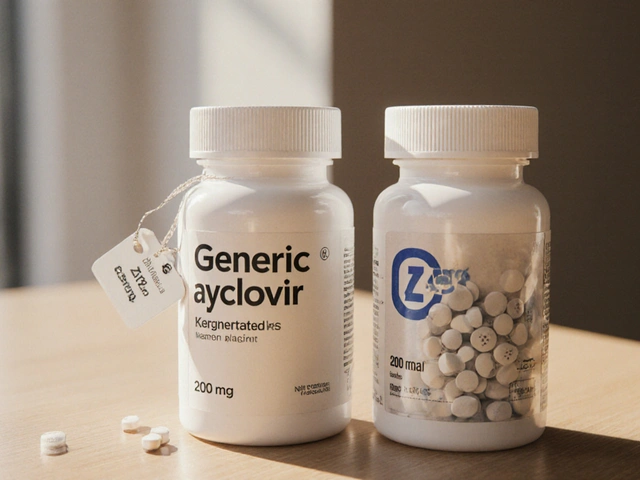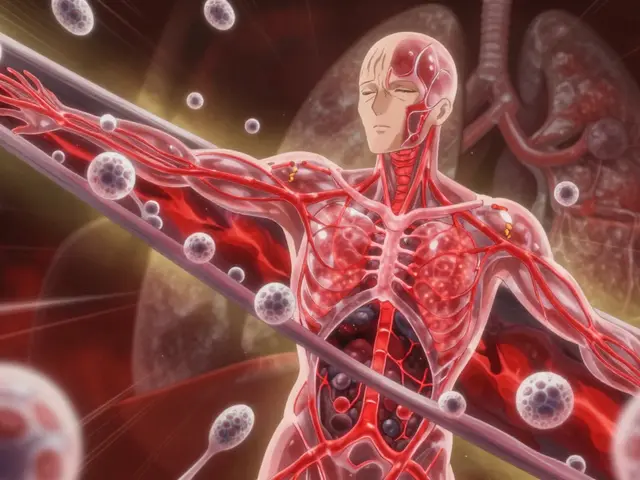Gut trouble and low calcium feed each other. If your digestion is off, you absorb less calcium. If your calcium is low, muscles and nerves-including the ones that run your gut-misfire. Expect a clear map of what links the two, the tests to ask for, and simple steps to get back to normal.
- TL;DR: Many gut conditions reduce calcium absorption; low calcium can worsen cramps, irregular bowels, and bone loss. Fix both together for best results.
- Start with food first: aim for 700-1,000 mg/day in the UK (SACN). Add vitamin D (10 µg/400 IU daily) to help absorption.
- When diet falls short, use calcium citrate if you have low stomach acid or take PPIs; split doses (≤500 mg elemental each).
- Ask your GP for serum calcium, albumin (or ionized calcium), 25(OH)D, PTH, magnesium, and, if risks are high, a bone density scan.
- Match tactics to your condition: celiac, IBD, IBS, bariatric surgery, pancreatic insufficiency, or long-term PPI use all need tweaks.
Why calcium and gut problems are tied together
Calcium does quiet work every second-tightening muscles, firing nerves, sealing the gut lining, and helping enzymes do their job. When levels drop, you feel it in many ways: tingling around the mouth, muscle cramps, shaky hands, and yes, a cranky gut.
Here’s the loop: gastrointestinal disorders cause malabsorption and dietary limits that lower calcium. In turn, low calcium can stir up smooth muscle spasms, worsen cramping, and chip away at the gut barrier. This doesn’t mean calcium alone causes IBS or colitis, but it often adds fuel to the fire.
Common ways gut issues drain calcium:
- Celiac disease: Villous atrophy cuts calcium and vitamin D absorption. People often avoid dairy early on due to temporary lactose intolerance.
- Inflammatory bowel disease (IBD): Inflammation, poor appetite, diarrhoea, and steroid use raise bone loss risk. Ileal disease/resection also increases oxalate absorption, pushing kidney stones unless calcium is taken with meals.
- Bariatric surgery (RYGB/sleeve): Less acid and a shorter gut reduce absorption. Calcium citrate is preferred; long-term monitoring is essential.
- Chronic pancreatitis/cystic fibrosis: Fat malabsorption binds calcium in the gut; vitamins A-E-K and D can also run low.
- Short bowel, chronic diarrhoea, or bile acid malabsorption: Fatty acids and bile acids tie up calcium and irritate the colon.
- Long-term proton pump inhibitors (PPIs): Low stomach acid can reduce calcium carbonate absorption; switch to citrate if needed.
- Diet patterns: Strict low-FODMAP, vegan without fortified foods, or dairy-free diets can undershoot calcium unless planned.
One more driver: vitamin D. If 25(OH)D is low, calcium absorption tanks. The body then raises parathyroid hormone (PTH) to pull calcium from bone to keep blood levels steady-so a “normal” serum calcium can hide a deficit. Magnesium also matters; severe low magnesium blunts PTH and stops vitamin D activation.
Evidence snapshot you can trust:
- UK SACN sets the adult RNI at 700 mg/day; EFSA’s adult upper level is 2,500 mg/day.
- The NHS advises 10 µg (400 IU) vitamin D daily, especially in autumn/winter.
- BSG guidelines flag early bone checks in newly diagnosed coeliac disease; NOGG (UK) supports calcium+vitamin D for bone health risk; ASMBS/BOMSS recommend calcium citrate after bariatric surgery.
- Randomised trials show calcium can bind irritants (bile acids/oxalate) in the colon and modestly lower recurrent polyp risk; it’s not a cure-all, but it helps some gut problems.
Spot it and confirm it: symptoms, red flags, and the right tests
First, listen to your body. Signs that low calcium may be part of your gut picture:
- Tingling or numbness around lips/fingers; muscle cramps, twitching, or spasms
- Cramping belly, bloating, or erratic bowels
- Fatigue, brain fog, brittle nails, dental changes
- Severe cases: lightheadedness, seizures, or heart rhythm issues (urgent)
Red flags that need quick medical review:
- Unintentional weight loss, blood in stool, black stools, fever, or night sweats
- Persistent diarrhoea (>4 weeks), waking at night to pass stool, or severe pain
- Fractures from minor falls, kidney stones, or very low vitamin D
Ask your GP for a simple, targeted panel. Step-by-step:
- Baseline labs: Serum calcium and albumin (or ionized calcium), phosphate, magnesium, alkaline phosphatase (ALP), creatinine/eGFR.
- Vitamin D and PTH: 25(OH)D plus PTH to spot secondary hyperparathyroidism when absorption is low.
- Screen for causes: Coeliac serology (tTG-IgA and total IgA). FBC and ferritin for anaemia. If chronic diarrhoea, consider faecal calprotectin (for IBD) and coeliac tests; if steatorrhoea, stool elastase (pancreatic insufficiency).
- Stones or high risks: 24-hour urine calcium, oxalate, citrate if recurrent stones or known malabsorption.
- Bone health: DEXA scan if you’ve had long malabsorption, steroid courses, fractures, menopause/ageing risk, or bariatric surgery (per NOGG/BOMSS guidance).
Handy lab tip: albumin-corrected calcium (UK units) ≈ measured calcium (mmol/L) + 0.02 × (40 − albumin g/L). If in doubt, ask for ionized calcium.
How to read the pattern:
- Low or low-normal calcium + low vitamin D + high PTH = poor absorption and bone drawdown.
- Low magnesium with low calcium = fix magnesium first or PTH won’t work well.
- Normal calcium doesn’t rule out low intake; the body may be robbing bone to compensate.
UK-specific note: these tests are standard on the NHS. If you’ve had a new coeliac diagnosis, British Society of Gastroenterology guidance supports early bone health assessment. After bariatric surgery, BOMSS guidance sets clear monitoring schedules for calcium, vitamin D, and PTH.

Fixing the deficit: food, supplements, and absorption tactics
Food first beats pills, especially for the gut. Aim for the UK RNI: 700 mg/day for most adults (SACN). Many people do better at 800-1,000 mg/day if they avoid dairy or have higher needs.
Practical food wins (approximate calcium per serving):
- 250 ml semi-skimmed milk: ~300 mg
- 150 g yogurt: ~200-250 mg
- 30 g hard cheese (e.g., cheddar): ~200 mg
- 250 ml fortified soy/oat milk: ~240-300 mg (check label)
- 100 g tofu (calcium-set): ~350-500 mg (brand dependent)
- 1 tbsp tahini (sesame paste): ~60-130 mg
- 80 g cooked kale/broccoli: ~60-120 mg
- 1 small can sardines with bones (100 g): ~250-300 mg
- UK wheat flour is fortified with calcium; two slices of bread can add a useful chunk
Simple day that hits the target: fortified porridge (250 ml fortified oat milk), sandwich with cheese or tofu, yogurt or fortified plant yogurt, greens at dinner, and canned salmon or beans. If you’re dairy-free, lean on fortified plant milks, calcium-set tofu, tahini, and fish with bones.
Vitamin D matters. The NHS recommends 10 µg (400 IU) daily for most adults, especially in autumn/winter. If your level is low, your GP may prescribe a short loading course then maintenance (often 800-2,000 IU daily). Magnesium from food (nuts, seeds, pulses, greens) supports the whole system.
Supplements: when and how
- Start small: If diet tops out at ~400 mg/day, add a 300-500 mg elemental calcium supplement.
- Split doses: Absorption is best at ≤500 mg elemental per dose.
- Choose the right form: Calcium carbonate is cheap and works best with meals and normal stomach acid. Calcium citrate absorbs well with low acid or on PPIs and is gentler for some people.
- Timing matters: Separate calcium by 2-4 hours from iron, levothyroxine, tetracyclines/quinolones, and oral bisphosphonates.
- Watch the ceiling: EFSA UL is 2,500 mg/day for adults (from diet + supplements). Don’t push it-more is not better.
- Side effects: Calcium can constipate. Fix with fluids, fibre, movement; switch to citrate; or discuss a small magnesium supplement with your clinician.
Smart absorption habits:
- Pair calcium with meals to bind oxalate and protect against stones (especially with ileal disease).
- Limit very high-oxalate foods (large spinach/almond loads) if you get stones; you don’t have to ban them.
- If you use PPIs long-term, review the need with your clinician; if needed, use the lowest dose that controls symptoms and prefer citrate.
| Condition | How it lowers calcium | Bone/stones risk | Practical steps |
|---|---|---|---|
| Celiac disease | Villous atrophy reduces Ca/Vit D absorption; dairy avoided early | High fracture risk early | Strict GF diet; 700-1,000 mg Ca/day; 400-800 IU Vit D; consider DEXA within 1 year |
| IBD (Crohn’s/UC) | Inflammation, diarrhoea, steroids; ileal disease → high oxalate | Bone loss; kidney stones | Meet Ca needs; calcium with meals to bind oxalate; check Vit D/PTH; limit steroids where possible |
| Bariatric surgery | Low acid and shorter gut lower absorption | Osteopenia/osteoporosis risk | 1,200-1,500 mg citrate split; Vit D maintenance; routine labs/DEXA per BOMSS/ASMBS |
| Chronic pancreatitis/CF | Fat binds calcium; low fat-soluble vitamins | Bone loss common | Pancreatic enzymes; Ca 700-1,000 mg; Vit D per labs; dietitian input |
| Long-term PPI use | Reduced acid lowers CaCO3 absorption | Modest bone risk | Use citrate; reassess PPI need; add Vit D; check Mg/B12 if long-term |
Rule of thumb: food + modest supplement + vitamin D + condition-specific tweaks beats high-dose pills alone.
Tailored playbooks for common gut disorders
Not all guts fail the same way. Tune your plan to your diagnosis.
Celiac disease
Once gluten is out, the gut heals and calcium absorption rebounds. Early on, use lactose-free dairy or fortified plant milks if regular milk bloats you. Target 700-1,000 mg/day calcium, routine vitamin D, and talk to your GP about a DEXA scan within a year of diagnosis if you’re an adult. BSG and Coeliac UK highlight bone health checks as standard.
Inflammatory bowel disease (Crohn’s/UC)
During flares, appetite crashes and absorption dips. Keep calcium coming in small, frequent, bland meals: yogurt or kefir if tolerated, fortified plant milks, tofu, eggs, soups with greens. If you’ve had ileal disease or resection, take calcium with meals to bind oxalate and lower stone risk. Ask about steroid-sparing treatments if you’re on repeated prednisolone courses. NOGG supports calcium+vitamin D for those at fracture risk; check 25(OH)D and PTH twice a year if disease is active.
IBS and low-FODMAP diets
Low-FODMAP diets often cut lactose and some fortified foods by accident. Keep calcium in with hard cheeses, lactose-free milk, lactose-free yogurt, or fortified plant milks (choose ones with calcium carbonate or tricalcium phosphate). Once symptoms settle, reintroduce foods to the highest tolerated level with a dietitian’s help (BDA recommends this). Don’t sit on the elimination phase for months.
Bariatric surgery (RYGB, sleeve)
Use calcium citrate, 1,200-1,500 mg elemental per day, split into 2-3 doses. Add vitamin D maintenance and follow your centre’s lab schedule (calcium, 25(OH)D, PTH, magnesium). BOMSS and ASMBS both call this out. Chewables or liquids help early on; switch forms as you heal. Expect a baseline DEXA within 1-2 years if risk is high.
Chronic pancreatitis or cystic fibrosis
Don’t skip enzymes. They improve fat absorption so calcium isn’t locked up with fatty acids. Use calcium-rich foods, regular vitamin D checks, and consider citrate if stools are oily despite enzymes. Work with a specialist dietitian-small changes in enzymes or fat can make a big difference.
GERD and long-term PPI therapy
Recheck the need for daily PPIs every few months. If you still need them, prefer calcium citrate, keep vitamin D steady, and ask for magnesium and B12 checks if you’ve been on PPIs long term. Some people do well stepping down to an H2 blocker or on-demand PPI after a period of control-do this with your GP.
Pregnancy, breastfeeding, and older adults
In the UK, the calcium RNI stays 700 mg/day during pregnancy and breastfeeding, but your total needs are practically higher. Hit 1,000 mg/day from diet if you can, and take 10 µg vitamin D daily unless advised otherwise. For older adults or anyone with falls, fractures, or steroid use, NOGG points to calcium+vitamin D as part of bone protection-speak to your clinician about the right targets for you.
Checklist: fast fixes and pitfalls
- Track a 3-day food log; if you’re under 700 mg/day, add fortified milk/tofu/cheese or a 300-500 mg supplement.
- Take calcium with meals; split doses; keep a 2-4 hour gap from iron/thyroid/antibiotics/bisphosphonates.
- If you’re on PPIs, use citrate. If you pass kidney stones, take calcium with meals and don’t overdo high-oxalate foods all at once.
- Ask for calcium, albumin (or ionized), 25(OH)D, PTH, magnesium. If chronic gut issues: add coeliac serology and faecal calprotectin.
- If diarrhoea is persistent or you’re losing weight, don’t wait-see your GP for work-up.
Mini‑FAQ
Can low calcium cause constipation or diarrhoea? It can contribute to both. Smooth muscle irritability and nerve changes can swing motility either way. The fix is balanced intake, fluids, fibre, movement-and addressing the gut disease.
How fast do supplements work? Symptoms like cramps may improve in days to weeks. Bone health is a long game-months to years-so stick with it and check labs.
Is calcium dangerous if I have kidney stones? Dietary calcium protects against common oxalate stones when eaten with meals. Very high-dose supplements away from food can raise stone risk; keep doses modest and with meals, and hydrate.
Which is better: carbonate or citrate? Carbonate is fine with meals if you make stomach acid normally. On PPIs or after bariatric surgery, citrate is usually better tolerated and absorbed.
What if my serum calcium is “normal” but I feel off? You could still be pulling calcium from bone. Check 25(OH)D, PTH, and magnesium to see the full picture.
Next steps and troubleshooting
- If you suspect a deficiency: Book labs (calcium, albumin or ionized, 25(OH)D, PTH, Mg, phosphate). Keep a 3-day diet log to bring along.
- If labs confirm low vitamin D or high PTH: Start vitamin D as advised; increase calcium to 700-1,000 mg/day with food; add a small supplement if needed.
- If you’re on PPIs or had bariatric surgery: Switch to citrate, split doses, and set calendar reminders for follow-up labs every 3-6 months the first year.
- If constipation hits after starting calcium: Swap to citrate, take with meals, add fluids/fibre, and consider a magnesium-rich food boost.
- If you have active IBD or coeliac symptoms: Treat the inflammation first. Supplements won’t fix malabsorption while the gut is flaring.
Key sources clinicians use: Scientific Advisory Committee on Nutrition (UK) on calcium; EFSA on upper limits; NHS advice on vitamin D; British Society of Gastroenterology (coeliac); National Osteoporosis Guideline Group (bone health); British Obesity and Metabolic Surgery Society and ASMBS (post-bariatric nutrition); and peer‑reviewed trials on calcium’s effects on bile acids, oxalate, and polyp recurrence. Ask your team to tailor these principles to your case.
If one phrase should stick, make it this: fix the gut and the calcium deficiency-together.








Rohini Paul
September 6, 2025 AT 09:50Been dealing with IBS and low calcium for years-this post nailed it. I started taking calcium citrate with meals after my last colonoscopy and my cramps dropped off like a bad habit. Also switched to fortified oat milk and now I don’t feel like a ghost by 3 PM.
Tiffany Fox
September 7, 2025 AT 23:14Calcium with meals = no more kidney stones. Game changer.
Luke Webster
September 9, 2025 AT 02:53I’m Indian-American and grew up on dairy, but after my diagnosis with celiac, I thought I was doomed. Turns out calcium-set tofu and tahini on toast are my new BFFs. Also, vitamin D in winter? Non-negotiable. This post made me feel less alone in the weird food world.
Big ups to the author for including non-dairy options without making it sound like a vegan pamphlet.
Natalie Sofer
September 10, 2025 AT 11:47so i just found out my ppi has been wrecking my calcium absorption?? like wtf?? i’ve been taking calcium carbonate for years and wonder why i still get muscle cramps… gonna switch to citrate tomorrow. thanks for this!!
Courtney Mintenko
September 10, 2025 AT 22:27Of course it's calcium. Everything is calcium. Next you'll tell me my anxiety is caused by low magnesium and my ex left me because I didn't take enough vitamin D. Wake up. The body is a machine. Stop overcomplicating it.
Sean Goss
September 12, 2025 AT 11:53Let’s be real-most of this is just observational correlation masquerading as clinical guidance. Serum calcium is a poor surrogate for total body calcium. You’re ignoring the role of FGF23, Klotho, and renal tubular reabsorption. Also, the EFSA upper limit is irrelevant if you’re not accounting for bioavailability in malabsorptive states. This is basic nutrition theater.
Khamaile Shakeer
September 13, 2025 AT 00:25Bro… calcium? Really? 😅 I thought it was all about gut flora… and now you’re telling me my bloating is from low calcium? I’m just here for the memes… but also… maybe… I should get tested? 🤔
Suryakant Godale
September 14, 2025 AT 01:38With due respect, the clinical recommendations presented herein are both evidence-based and methodologically sound. The integration of serum calcium, albumin-adjusted values, and parathyroid hormone dynamics reflects current endocrine-gastroenterological consensus. I would, however, recommend the addition of a reference to the 2021 European Society for Clinical Nutrition and Metabolism guidelines on micronutrient replacement in intestinal failure.
John Kang
September 14, 2025 AT 18:38Good stuff. Start small. Stay consistent. Your gut will thank you. And don’t stress if you miss a day-just get back on it tomorrow.
Bob Stewart
September 16, 2025 AT 09:26The data presented is largely consistent with the 2022 National Osteoporosis Guideline Group recommendations and the British Society of Gastroenterology guidelines on coeliac disease. However, the omission of the role of vitamin K2 in osteocalcin activation represents a notable gap in the nutritional strategy outlined. Further, the assertion that calcium citrate is universally preferable in PPI users lacks distinction between proton pump inhibitor potency and gastric pH profiles.
Simran Mishra
September 18, 2025 AT 07:11I’ve been on PPIs for 8 years… I started having panic attacks at night… I thought it was stress… then I found out my calcium was 7.8 and my vitamin D was 12… I cried in the doctor’s office… I didn’t know my body was starving… I just thought I was broken… I’m on supplements now… I sleep through the night… I still feel like I’m walking through fog sometimes… but it’s lighter now… thank you for writing this… I didn’t know anyone else felt this way…
ka modesto
September 20, 2025 AT 04:31I’m a dietitian and this is one of the clearest summaries I’ve seen on calcium and gut health. Love the food examples and the split-dose advice. Also, the table? Chef’s kiss. Sharing this with all my IBD clients.
Holly Lowe
September 21, 2025 AT 04:45My gut was throwing a rave and my bones were throwing a funeral. This post was the bouncer who kicked out the chaos and handed me a calcium citrate smoothie. Now I’m not just surviving-I’m vibin’.